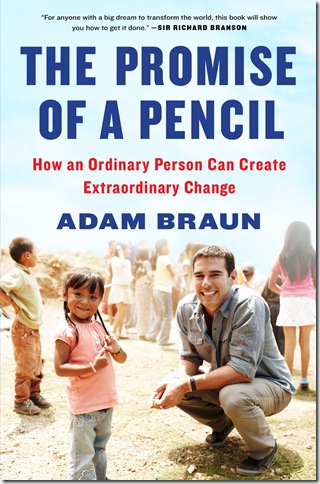Growing up in wealthy Greenwich, Conn., Adam Braun developed an “obsession” with Wall Street and dreamed of “becoming a billionaire.
While in college he traveled abroad in the Semester at Sea program, which introduces students to different cultures. Braun decided to ask children he encountered in each nation what they would choose if they could have anything in the world.
In India he met a boy who had been begging for money. After Braun inquired what he would pick if he could have anything, the boy thought for a moment before responding “a pencil.” When Braun pulled a pencil from his backpack, the boy looked at it “as if it were a diamond.”
The author soon realized that millions of children around the world have no pencils, paper, books, teachers or schools.
Back home, he decided to pursue a lucrative career in management consulting with Bain & Co., keeping in mind his dream of building schools in isolated villages in Third World nations. In his spare time, he launched Pencils of Promise by opening a bank account with $25. The year was 2008 and Braun was 24 years old.
The Promise of a Pencil combines anecdotes, fundraising tips and the author’s belief that, in the words of the subtitle, “ordinary people can create extraordinary change.”
The first school opened in Laos in 2009. Since then Pencils of Promise has constructed more than 200 schools and has set a goal of 500 schools by the end of next year – an extraordinary achievement by any standard.
Braun eventually realized he could not juggle a full-time corporate career with his growing commitment to building schools. Reluctantly, he quit his job.
Before Pencils of Promise builds a school, it insists that local villagers pick up 10 percent of the tab, either in cash, labor or donated materials. Another bedrock practice is that 90 percent of the non-profit’s employees abroad are local residents. Braun faults groups that enter a country, build a school or other facility and then leave town. Rather, he envisions a continuing relationship.
Braun shares his fundraising techniques, while admitting he had trouble asking prospective donors for money. But he overcame that fear, once inquiring if a wealthy benefactor would donate $300,000 spread over three years. The donor thought it over, then said yes. Scores of people have stepped forward to raise money for the non-profit. A 17-year-old California girl bicycled across America, raising $10,000 in pledges.
Donors are told that $25 will educate one child, $10,000 will build a classroom and $25,000 will pay for a whole school.
One of the book’s most touching scenes involves Braun’s relationship with his grandmother, who had escaped the Holocaust and had inspired the author to follow his dreams. When the first school in Laos opened, Braun installed a plaque over the door, dedicating the building to his grandmother. When he showed her a picture of the plaque, she burst into tears of love and gratitude.
I have a few reservations about the book. Braun cannot seem to get out of the way of his boastful personality. One senses that the story would have had more credibility if someone unconnected to Pencils of Promise had written the book.
We also learn precious little about the schools and what impact they have had on the children in remote villages in Asia, South America and Africa.
Braun also relies too much on trite phrasing and clichés: “I felt like a man on fire.” “Sometimes you have to fake it until you make it.” “My heart was beating out of my chest.” “We were hitting on all cylinders.” “It literally knocked the wind out of me.”
That said, Braun deserves credit for inspiring donors to support his audacious plan to build hundreds of schools, providing thousands of poor children with the gift of literacy.
The Promise of a Pencil: How an Ordinary Person Can Create Extraordinary Change, By Adam Braun; Scribner, 254 pp., $25
Bill Williams is a freelance writer in West Hartford, Conn., and a former editorial writer for The Hartford Courant. He is a member of the National Book Critics Circle and can be reached at billwaw@comcast.net.
